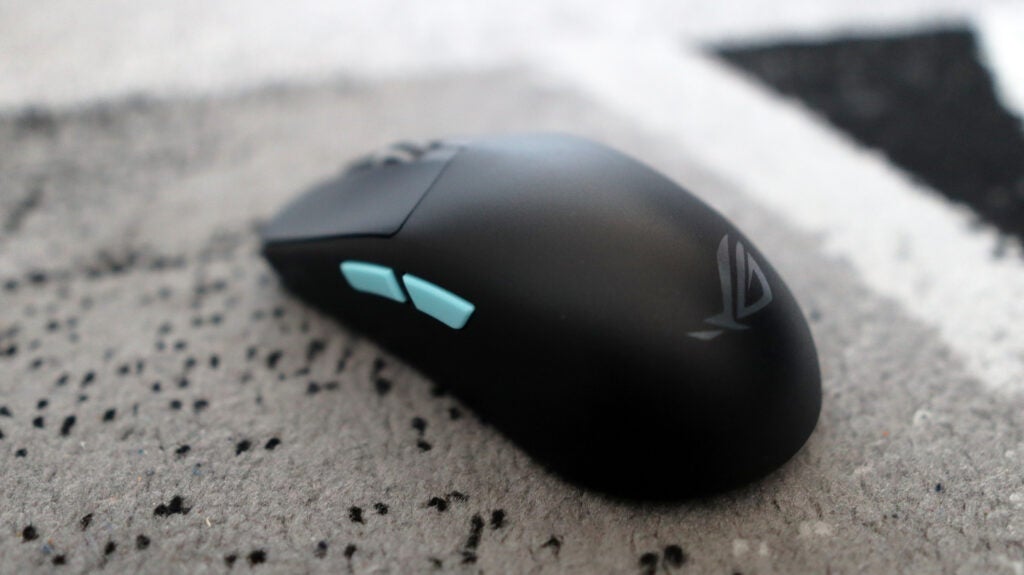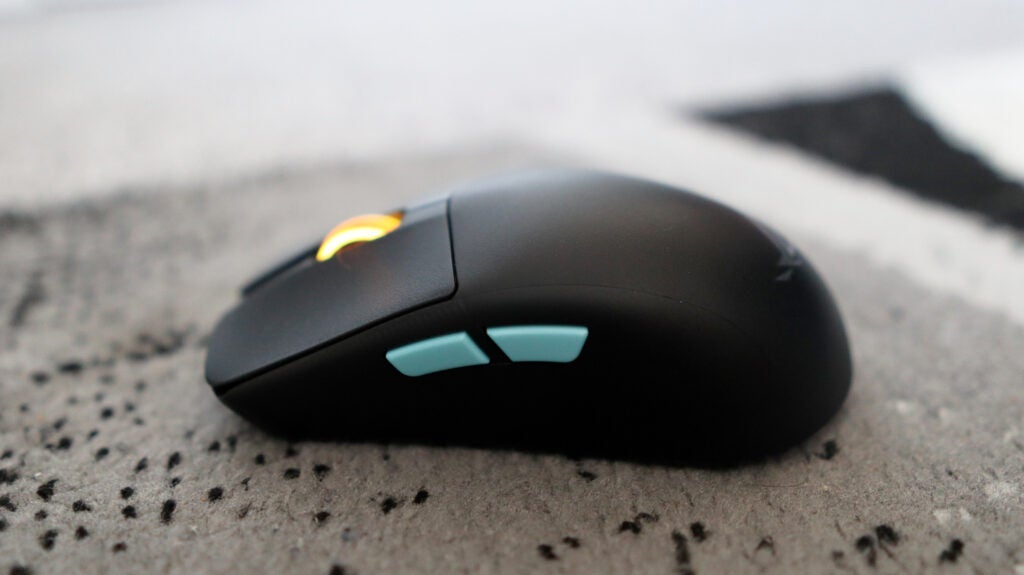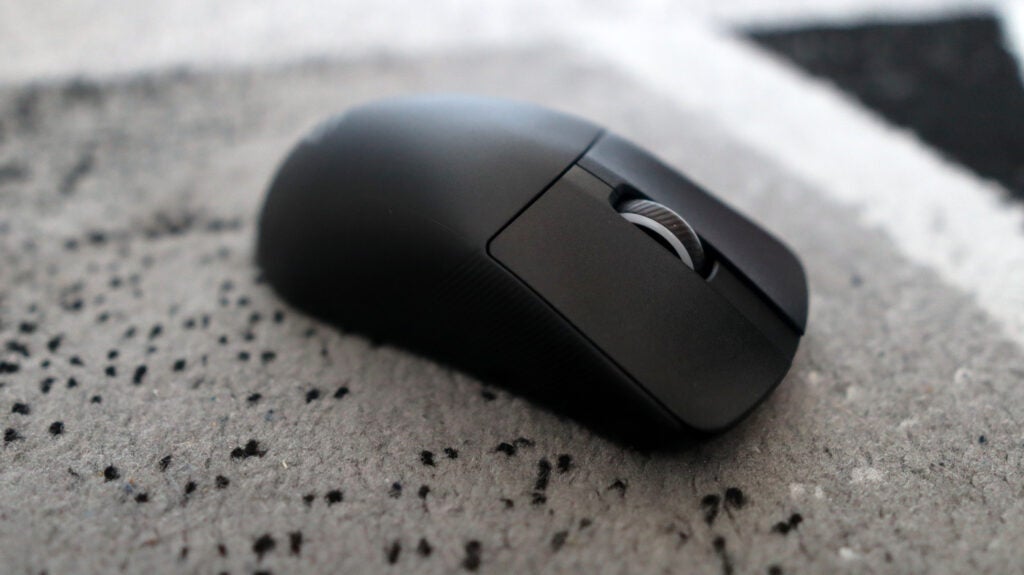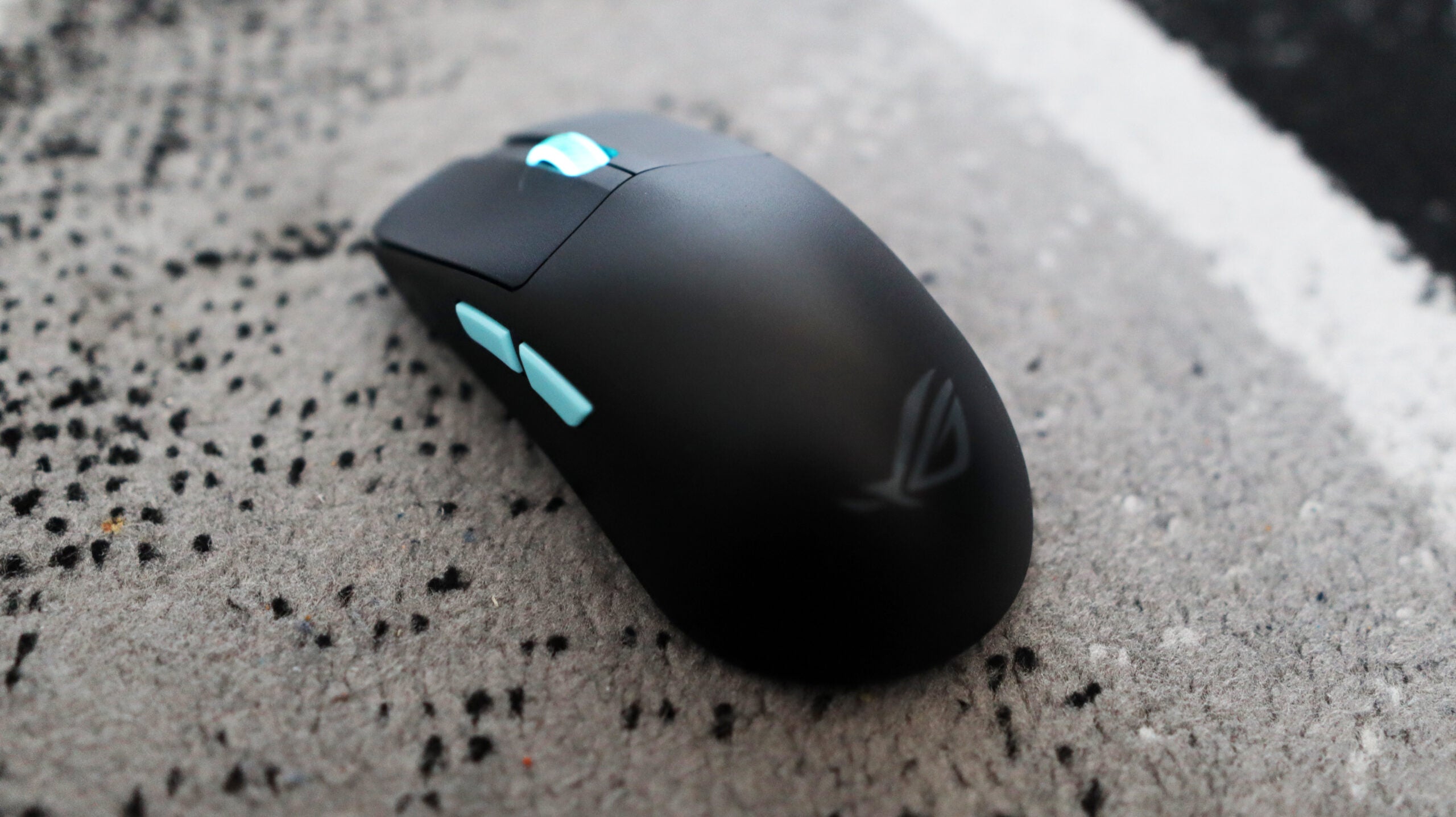Verdict
The Asus ROG Harpe Ace Aim Lab Edition is one of the most powerful gaming mice I’ve ever used, while also sporting a solid battery life and connectivity, combined with a comfortable shape. The accompanying software is good too, although such a large install may put you off, as could the high price.
Pros
- Zanily powerful
- Comfortable for smaller hands
- Functional software and lightning
Cons
- Expensive
- Software is fiddly to install
- Chassis may not suit all hand sizes
Availability
- UKRRP: £139.99
- USARRP: $169.99
- EuropeRRP: €167.9
Introduction
Asus really has started 2023 off with a bang when it comes to peripherals, not only with their amazing ROG Azoth keyboard, but also the mouse I’ve been taking a look at recently too – the all-new Asus ROG Harpe Ace Aim Lab Edition.
Clocking in at £140/$170/€170, it’s one of the most expensive (and lightest) mice I’ve taken a look at in a very long time, but a spec sheet that boasts a 36,000 DPI mouse in a 54g with the pedigree of Aim Lab should make for something pretty special. Here are my thoughts.
Design
- Supremely lightweight chassis
- Minimalistic design looks good
- Narrow chassis means it’s best in smaller hands
It’s fair to say that the ROG Harpe Ace isn’t exactly the flashiest of gaming mice, despite its high markup. Instead it opts for an understated and minimalistic look to it, akin to the likes of the Logitech G Pro X Superlight and the Razer DeathAdder V3 Pro.
It has an interesting shape, which is quite unique among mice designed for the pros. It’s an especially narrow one, which will prove great if you’re someone with small hands. My hands are on the smaller side, but the fact this mouse was so narrow did take some getting used to, and meant that my usual palm grip wasn’t quite as comfortable as the claw grip I had to get used to.

Combined with that narrow frame, this Asus x Aim Lab mouse is also ridiculously light, with a mass of just 54g. I’ve used a few ultra lightweight mice in the past, but I think the Harpe Ace makes for the absolute lightest one I’ve ever used. While I’m not necessarily the biggest fan of such light mice, for the pros out there, it’s easy to see the appeal. A large reason why the Harpe Ace is so light is because its outer shell is made of nylon, which feels sturdy, and the textured finish also helps this mouse to feel pretty comfortable in hand.
There are a total of seven buttons here, which also gives you all the functions you need, with little else to worry about. Placement is largely standard, although the forwards and backwards buttons feature this bright Aim Lab-blue colouring which provides a nice contrast to the otherwise black chassis of the Harpe Ace.
On the underside, it features a selection of PTFE glide pads for smooth control, as well as storage for the bundled USB receiver, and two buttons for controlling the DPI levels of the Harpe Ace and switching between different profiles. I’d have preferred to see the DPI button on the top, perhaps just below the scroll wheel, but it seems to be becoming more standard for it to go on the bottom so you only change the sensitivity when you need to.
Performance
- 36,000 DPI sensor is zanily powerful
- Mechanical mouse buttons feel excellent
- Battery life and connectivity are solid
The big reason for grabbing the Asus ROG Harpe Ace Aim Lab isn’t just because of its minimalistic looks, but more so because of what’s inside it. A 36,000 DPI sensor on a mouse this light is quite frankly ridiculous and makes this the highest DPI mouse I think I’ve ever had the pleasure of testing.
Truth be told, once you get past probably 12,000 DPI, the differences between a lot of gaming mice are blurred. But when needed, the Harpe Ace is quick and accurate. A minute flick of the wrist can send you flying around the map in order to kill enemies in FPS titles, where this mouse shines particularly.
Of course, 36,000 DPI isn’t for everyone, and in testing the Harpe Ace outside of rounds of CS:GO and Apex Legends, it just proved to be a little too skittish for me; for work, I’ll stick with my trusty Logitech MX Master 3S.

The mouse buttons on offer use Asus’ own mechanical switches, and while they aren’t optical like some other manufacturers, that may not be such a bad thing. In practice, they felt excellent, with marvellous tactility, even when I was spamming to shoot aimlessly at enemies. A total lifespan of 70 million clicks is also testament to their solid reliability.
Unlike the DeathAdder V3 Pro, the Harpe Ace not only ships with the ability to connect via the ultra-speedy USB-A receiver, but also via Bluetooth, too. This means if you want to preserve speed over battery life (or vice versa) then you can. Connecting the Harpe Ace is also plug and play, which keeps things especially easy.
As for battery life, Asus says the Harpe Ace should last for up to 90 hours on the receiver, or up to 98 hours on Bluetooth. Usually, there’s a bit more of a gap between the two means, but it’s a solid runtime and the Harpe Ace will be good to last for a good few weeks’ worth of gaming before needing to be charged back up via USB-C.
Software and lighting
- ROG Armoury software is okay in terms of functions
- Aim Lab Settings Organiser is a pain to install
- Single RGB lighting zone keeps things simple
It’s nice that Asus has paid a little bit more attention on the software side of things especially with this Aim Lab collaboration, as you get two pieces of software to take advantage of.
Asus’ ROG Armoury Crate is pretty standard by this point, and provides you with the chance to remap the Harpe Ace’s buttons, as well as to configure the single lighting zone on offer, for instance. My only issue is how long Armoury Crate can take to load, but be patient, and you’ll be fine.

You’ll also need to be patient in order to use the Aim Lab Settings Organiser suite, which provides you with even more precise control over the Harpe Ace and its settings. This is because if you don’t have Aim Lab installed already, you’ll need to head on over to Steam and wait for a 12GB install to complete. I do think it’s worth the wait, given the vast level of functionality on offer – there’s everything from changing the DPI to angle tuning and customising the mouse’s lift-off distance, too.
Things are turned down a little when we come back to the singular lighting zone the Harpe Ace has. It’s not the Asus logo, as you may have initially expected, but the scroll wheel’s outer edges. For those who may not be the biggest fans of oodles of RGB, but still want to add a smattering of colour, this is an ideal fit.
Latest deals
Should you buy it?
You want an incredibly powerful gaming mouse:
There aren’t many gaming mice more powerful than the Asus ROG Harpe Ace Aim Lab Edition, so if it’s absolute speed and precision you’re after from your next mouse, this is the one to go for.
You’ve got larger hands:
While the Asus ROG Harpe Ace Aim Lab Edition is quite the all-conquering gaming mouse, its chassis isn’t the best for those with larger hands. You may wish to go for a wider, and possibly heavier, mouse in order for things to be more comfortable for you.
Final Thoughts
It seems the Asus ROG Harpe Ace Aim Lab Edition is adhering to the recent trend of gaming mice getting lighter but offering high levels of sensitivity in the process with the combo of 36,000 DPI and a 54g weight chassis. While it may not be for everyone, competitive gamers will be hard-pressed to find a more accurate mouse to use for high-intensity games.
It’s also especially well made, and comfortable for those with hands on the smaller side. My only major gripe here is with the software and how big one of the installs is, but if you can look past that, this is an excellent gaming mouse and a surefire choice for one of the best wireless gaming mice of 2023 already.
How we test
We use every mouse we test for at least a week. During that time, we’ll check it for ease of use and put it through its paces by playing a variety of different genres, including FPS, strategy and MOBAs.
We also check each mouse’s software to see how easy it is to customise and set up.
FAQs
Yes, the Asus ROG Harpe Ace Aim Lab Edition uses Bluetooth technology, as well even faster wireless via the bundled USB dongle.
Jargon buster
DPI
DPI stands for “Dots Per Inch” and measures the sensitivity of a mouse. A higher DPI figure will see the mouse cursor travel a greater distance from the same wrist movement, making it very useful for competitive gaming.
Verdict
The Asus ROG Harpe Ace Aim Lab Edition is one of the most powerful gaming mice I’ve ever used, while also sporting a solid battery life and connectivity, combined with a comfortable shape. The accompanying software is good too, although such a large install may put you off, as could the high price.
Pros
- Zanily powerful
- Comfortable for smaller hands
- Functional software and lightning
Cons
- Expensive
- Software is fiddly to install
- Chassis may not suit all hand sizes
Availability
- UKRRP: £139.99
- USARRP: $169.99
- EuropeRRP: €167.9
Introduction
Asus really has started 2023 off with a bang when it comes to peripherals, not only with their amazing ROG Azoth keyboard, but also the mouse I’ve been taking a look at recently too – the all-new Asus ROG Harpe Ace Aim Lab Edition.
Clocking in at £140/$170/€170, it’s one of the most expensive (and lightest) mice I’ve taken a look at in a very long time, but a spec sheet that boasts a 36,000 DPI mouse in a 54g with the pedigree of Aim Lab should make for something pretty special. Here are my thoughts.
Design
- Supremely lightweight chassis
- Minimalistic design looks good
- Narrow chassis means it’s best in smaller hands
It’s fair to say that the ROG Harpe Ace isn’t exactly the flashiest of gaming mice, despite its high markup. Instead it opts for an understated and minimalistic look to it, akin to the likes of the Logitech G Pro X Superlight and the Razer DeathAdder V3 Pro.
It has an interesting shape, which is quite unique among mice designed for the pros. It’s an especially narrow one, which will prove great if you’re someone with small hands. My hands are on the smaller side, but the fact this mouse was so narrow did take some getting used to, and meant that my usual palm grip wasn’t quite as comfortable as the claw grip I had to get used to.

Combined with that narrow frame, this Asus x Aim Lab mouse is also ridiculously light, with a mass of just 54g. I’ve used a few ultra lightweight mice in the past, but I think the Harpe Ace makes for the absolute lightest one I’ve ever used. While I’m not necessarily the biggest fan of such light mice, for the pros out there, it’s easy to see the appeal. A large reason why the Harpe Ace is so light is because its outer shell is made of nylon, which feels sturdy, and the textured finish also helps this mouse to feel pretty comfortable in hand.
There are a total of seven buttons here, which also gives you all the functions you need, with little else to worry about. Placement is largely standard, although the forwards and backwards buttons feature this bright Aim Lab-blue colouring which provides a nice contrast to the otherwise black chassis of the Harpe Ace.
On the underside, it features a selection of PTFE glide pads for smooth control, as well as storage for the bundled USB receiver, and two buttons for controlling the DPI levels of the Harpe Ace and switching between different profiles. I’d have preferred to see the DPI button on the top, perhaps just below the scroll wheel, but it seems to be becoming more standard for it to go on the bottom so you only change the sensitivity when you need to.
Performance
- 36,000 DPI sensor is zanily powerful
- Mechanical mouse buttons feel excellent
- Battery life and connectivity are solid
The big reason for grabbing the Asus ROG Harpe Ace Aim Lab isn’t just because of its minimalistic looks, but more so because of what’s inside it. A 36,000 DPI sensor on a mouse this light is quite frankly ridiculous and makes this the highest DPI mouse I think I’ve ever had the pleasure of testing.
Truth be told, once you get past probably 12,000 DPI, the differences between a lot of gaming mice are blurred. But when needed, the Harpe Ace is quick and accurate. A minute flick of the wrist can send you flying around the map in order to kill enemies in FPS titles, where this mouse shines particularly.
Of course, 36,000 DPI isn’t for everyone, and in testing the Harpe Ace outside of rounds of CS:GO and Apex Legends, it just proved to be a little too skittish for me; for work, I’ll stick with my trusty Logitech MX Master 3S.

The mouse buttons on offer use Asus’ own mechanical switches, and while they aren’t optical like some other manufacturers, that may not be such a bad thing. In practice, they felt excellent, with marvellous tactility, even when I was spamming to shoot aimlessly at enemies. A total lifespan of 70 million clicks is also testament to their solid reliability.
Unlike the DeathAdder V3 Pro, the Harpe Ace not only ships with the ability to connect via the ultra-speedy USB-A receiver, but also via Bluetooth, too. This means if you want to preserve speed over battery life (or vice versa) then you can. Connecting the Harpe Ace is also plug and play, which keeps things especially easy.
As for battery life, Asus says the Harpe Ace should last for up to 90 hours on the receiver, or up to 98 hours on Bluetooth. Usually, there’s a bit more of a gap between the two means, but it’s a solid runtime and the Harpe Ace will be good to last for a good few weeks’ worth of gaming before needing to be charged back up via USB-C.
Software and lighting
- ROG Armoury software is okay in terms of functions
- Aim Lab Settings Organiser is a pain to install
- Single RGB lighting zone keeps things simple
It’s nice that Asus has paid a little bit more attention on the software side of things especially with this Aim Lab collaboration, as you get two pieces of software to take advantage of.
Asus’ ROG Armoury Crate is pretty standard by this point, and provides you with the chance to remap the Harpe Ace’s buttons, as well as to configure the single lighting zone on offer, for instance. My only issue is how long Armoury Crate can take to load, but be patient, and you’ll be fine.

You’ll also need to be patient in order to use the Aim Lab Settings Organiser suite, which provides you with even more precise control over the Harpe Ace and its settings. This is because if you don’t have Aim Lab installed already, you’ll need to head on over to Steam and wait for a 12GB install to complete. I do think it’s worth the wait, given the vast level of functionality on offer – there’s everything from changing the DPI to angle tuning and customising the mouse’s lift-off distance, too.
Things are turned down a little when we come back to the singular lighting zone the Harpe Ace has. It’s not the Asus logo, as you may have initially expected, but the scroll wheel’s outer edges. For those who may not be the biggest fans of oodles of RGB, but still want to add a smattering of colour, this is an ideal fit.
Latest deals
Should you buy it?
You want an incredibly powerful gaming mouse:
There aren’t many gaming mice more powerful than the Asus ROG Harpe Ace Aim Lab Edition, so if it’s absolute speed and precision you’re after from your next mouse, this is the one to go for.
You’ve got larger hands:
While the Asus ROG Harpe Ace Aim Lab Edition is quite the all-conquering gaming mouse, its chassis isn’t the best for those with larger hands. You may wish to go for a wider, and possibly heavier, mouse in order for things to be more comfortable for you.
Final Thoughts
It seems the Asus ROG Harpe Ace Aim Lab Edition is adhering to the recent trend of gaming mice getting lighter but offering high levels of sensitivity in the process with the combo of 36,000 DPI and a 54g weight chassis. While it may not be for everyone, competitive gamers will be hard-pressed to find a more accurate mouse to use for high-intensity games.
It’s also especially well made, and comfortable for those with hands on the smaller side. My only major gripe here is with the software and how big one of the installs is, but if you can look past that, this is an excellent gaming mouse and a surefire choice for one of the best wireless gaming mice of 2023 already.
How we test
We use every mouse we test for at least a week. During that time, we’ll check it for ease of use and put it through its paces by playing a variety of different genres, including FPS, strategy and MOBAs.
We also check each mouse’s software to see how easy it is to customise and set up.
FAQs
Yes, the Asus ROG Harpe Ace Aim Lab Edition uses Bluetooth technology, as well even faster wireless via the bundled USB dongle.
Jargon buster
DPI
DPI stands for “Dots Per Inch” and measures the sensitivity of a mouse. A higher DPI figure will see the mouse cursor travel a greater distance from the same wrist movement, making it very useful for competitive gaming.

























